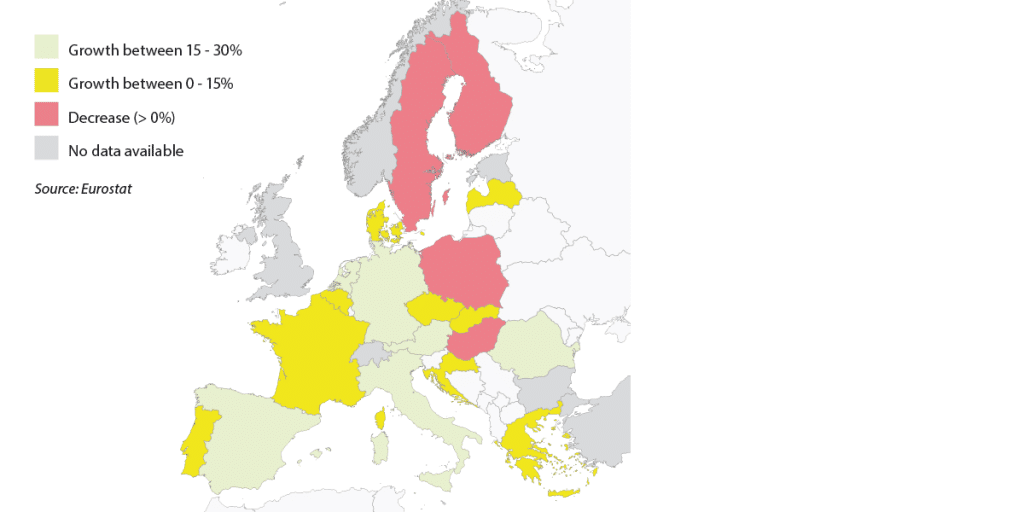Overview of the European camping landscape in 2023
The European tourism sector has demonstrated its resilience in recent years. In 2023, there were no fewer than 2.9 million overnight stays in European tourist accommodation. That is an increase of 6.1% compared to 2022 and an increase of 1.4% compared to the pre-COVID year of 2019. ACSI zoomed in on the camping sector and looked at whether it is back at the 2019 level. To gain a good overview of the European camping landscape, we compared the number of overnight stays in 2023 with the number in 2019. Furthermore, we zoomed in on the figures for some countries and looked at explanations and market developments to clarify these figures.
Camping in Denmark
In Denmark, the number of overnight stays grew by 10.8% in 2023 compared to 2019. However, compared to 2022 there is a decline of 4.1% This is due to a big decline in tourists from Norway
and Sweden. Although the number of domestic overnight stays remains high, the relative percentage has fallen slightly from 71% in 2019 to approximately 66% in 2023. This shows a positive trend in
the number of foreign visitors. The most popular destination is Syddanmark, the region in the south of Denmark (which accounts for 25% of the total overnight stays among foreign tourists).
Camping in France
In France, the number of overnight stays has grown steadily. With a total of 141,673,269 overnight stays in 2023, the number increased by 4.4% compared to the previous year. Compared to 2019, there is even a 10.2% growth. The majority of the number of overnight stays (ca. 70%) comes from foreign tourists. Some regions did extremely well: As such, the 2023 high season brought a record number of visitors (both domestic and foreign) to campsites in the Bourgogne-Franche-Comté region. The departments of Côte d’Or, Saôneet- Loire, Jura and Doubs count for 79% of the tourism within this region. The French camping sector noticed that many Europeans have returned, but noted that was not the case for Italian tourists.
Camping in Spain
In 2023, Spain had the highest number of overnight stays in recent years at 47,286,134. That means a growth of 16.1% compared to 2019. A small majority (54.5%) of the number of overnight stays came from domestic visitors. This share rose slightly compared to 2019, meaning the share of foreign tourists fell.
Campsites along the Mediterranean Sea coast in particular remain highly dependent on foreign tourists, mainly from the Netherlands, France, Germany and the United Kingdom. Fortunately, there is also
an upward trend here. Due to this positive trend, Spain is slowly recovering from the disastrous effects of the corona crisis.

Italy
Tourism is also picking up in Italy after some difficult years. At around 69,500,000, the number of overnight stays was higher than in recent years and has passed the 2019 level. The ratio of foreign to domestic tourists has shifted slightly in these years. Whereas just under half of visitors were foreign tourists in 2019, this has grown to 55% in 2023. This confirms the picture that foreign guests have found their way to Italy again, and this has traditionally been the cork on which Italian tourism thrives. Last year, northern Italy in particular did well and tourism in the central part of Italy also picked up. However, the bad weather in the months of June and July caused slightly fewer visits by foreign tourists in southern
Italy and the islands.
Holidays in Germany
With a total of 42,389,291 in 2023, Germany had the highest number of overnight stays in recent years. Domestic tourism is a significant part of this. The percentage of domestic overnight stays (86-89.4%) is remarkably high in Germany and has only increased since the COVID-19 pandemic. The total of overnight stays, including in hotels, increased by 8.1% in 2023 compared to 2022, however there is a decline of 1.7% compared to 2019. The fact that the number of overnight stays in the same period (2023 vs. 2019) has increased by 18.6%, shows that the popularity of camping has greatly increased in Germany too.
Holidays in the Netherlands
In 2023, the Netherlands noted the highest number of overnight stays in recent years at no fewer than
28,379,344. This means a growth of 29.7% compared to 2019. The majority of these overnight stays (ca. 73% both in 2019 as well as 2023) came from domestic tourists. The most popular Dutch provinces are
Zeeland, Gelderland and North Holland, which is mostly thanks to domestic overnight stays. The exception to this rule is Zeeland, which has also seen many German tourists coming to spent the night.
Camping in Croatia
In 2023, Croatia had the highest number of overnight stays in recent years at 21,643,844. This is a clear growth of 12.8% compared to 2019. It is notable that a very small percentage of overnight stays (ca. 3%) come from foreign tourists, although this number did increase by a few percent in 2023 compared to 2019. Campsites note a positive trend in foreign tourists, but also notice that, considering the price increases, they often choose a relatively cheap and lower quality option. Furthermore, they see a considerable decline in guests from Italy.
Facing the future with optimism
The figures show that the camping industry has recovered from the COVID-19 pandemic in many places.
Frank Jacobs, Manager Business Development at ACSI, shares this conclusion.
‘It is no secret that it was precisely during the COVID-19 pandemic that camping gained in popularity. During that time, many new target groups became interested in camping. For example, people who first opted for a flight holiday and stayed in a hotel or flat. They have now (also) discovered camping and invested in buying camping equipment and supplies. You often don’t do that for one year.’
In this regard, a domestic holiday is an option for more and more people. ‘During the COVID-19 pandemic, a domestic holiday was the only option for many campers. As a result, the home market has grown or emerged. For campsites, this is good news because it makes them less dependent on foreign campers.’ Jacobs notes at the same time that foreign tourism is also on the rise again. ‘Tourists are visiting the Spanish costas and regions like Provence-Côte-d’Azur and Languedoc- Roussillon again too. This creates a nice balance between domestic and foreign tourism.’
Then there is the discussion about climate change. Is this causing countries in southern Europe to become less popular with holidaymakers in high season? ‘With campers, we don’t see that picture yet,’ Jacobs points out. ‘I also think it depends on the type of camper. Sunny weather is just less guaranteed in northern Europa. We experienced that last summer. I therefore expect that sun seekers will continue
to go south. But there are certainly also people who will choose cooler destinations because of the heat anyway and travel north,’ Jacobs concludes.
